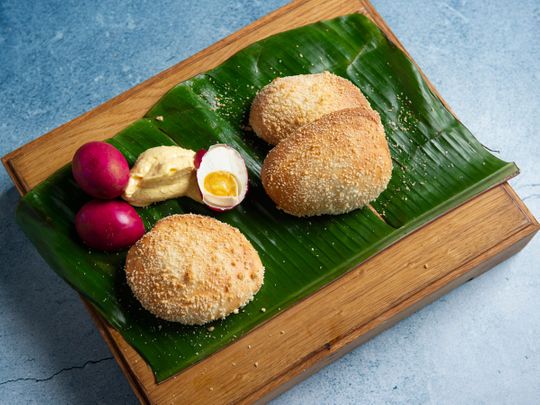Ingredients
For Pandesal bread
1 kg all-purpose flour
80 gms powdered milk
200 gms granulated white sugar
1 tbsp salt
2 tsp bread improver
4 tsp yeast (dry)
2 large eggs
30 gms (2 tbsp) shortening
90 gms unsalted butter
¾ cups (450 gms) water
3 tbsp coarse bread crumbs
For Salted Red Egg Butter
2 Salted Red Duck Eggs (available in Asian supermarkets)
500 gms unsalted butter
Method
Pandesal Bread
1. Dissolve yeast in warm milk that is at room temperature and add 2 tsp of sugar. Stir to combine. Let the mixture stand 5-10 minutes until yeast has activated and mixture is foamy.
2. In a large bowl mix all the dry ingredients – the flour, milk powder, bread improver, sugar and salt – and set it aside.
3. In a separate bowl, mix the butter, shortening, water and eggs and lightly whisk it. Add the yeast activated milk to this.
4. Now, combine the wet and dry ingredients until it forms a dough.
5. Dust your counter or work surface with flour and knead the dough in a circular motion until all ingredients blend together to form a smooth ball.
6. Check if gluten has formed in your dough – gently tease the dough apart with your fingers and if it forms a thin film as it breaks apart, your dough is ready.
7. Rest your dough for around 20 minutes.
8. Roll the dough out into a log and use a knife to slice it into equal parts of 2 inches.
9. The sliced dough will have tapered ends from the knife pushing down on it. Do not reshape it and retain this slightly oval form which is the key feature that distinguishes pandesal from other white bread rolls.
10. Coat the portioned dough in breadcrumbs for extra crunch and texture. Lay them out on a well-greased baking tray.
11. Proof the portioned dough – cover it with a damp cloth and let it rest for 30 minutes, so the dough rises to become fluffier and airy. At the end of the 30 minutes, your leavened dough will have doubled in size.
12. Preheat oven to 180C. Bake the pandesals for 15-20 minutes until fragrant and golden brown.
Salted Red Egg Butter
Note: Itlog na pula (which translates to red egg in Tagalog) are a cheerful fuchsia presence in Asian supermarkets and instantly grab eyeballs. Dyed red to distinguish them from unsalted duck eggs, these are usually cured in clay, salt and water.
1. Let your refrigerated butter sit in a bowl outside until it softens to room temperature. Put the softened stick of butter in a bowl and whisk well to aerate it. The butter turning a lighter shade of yellow is you cue that it has become airy.
2. Peel the salted duck eggs and cut them into halves. If you prefer a chunky texture, throw in the eggs straight into the bowl of butter and mash it up with a fork to blend it in.
3. For a smoother texture pass the yolks through a sieve and blend the smoothened egg paste into the butter with a whisk, fork or spoon for 15 minutes.
4. Refrigerate the egg-mixed butter for 10 minutes so it sets and attains a thicker consistency.
Share your food stories and recipes with us on food@gulfnews.com





